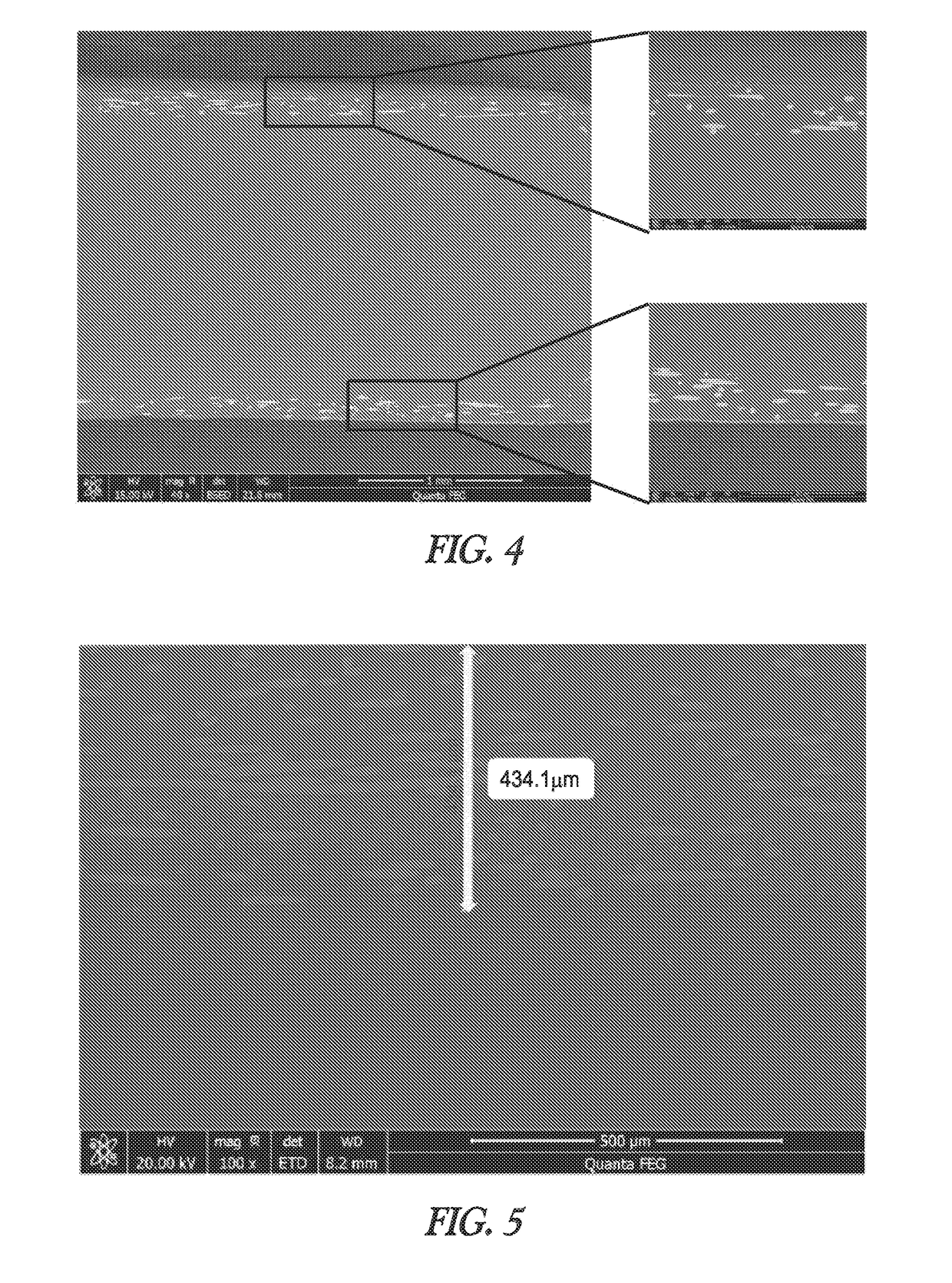Filler-reinforced solid resin multilayered structure
- Summary
- Abstract
- Description
- Claims
- Application Information
AI Technical Summary
Benefits of technology
Problems solved by technology
Method used
Image
Examples
example 1.1
uality
[0078]Two extruded 120 micron-thick glass fiber-filled films were placed on the top and bottom of a pressed glass fiber-free film such that the extrusion direction of each extruded film was in parallel. The press was preheated to 160° C. The stack was pressed from the top and bottom sides using the press at 160° C. for 5 seconds, followed by cooling by injecting 40° C. water into cooling channels in the press. FIG. 4 illustrates a scanning electron microscope (SEM) image of the laminated structure formed. No interface was visible between the layers of the laminated structure formed.
[0079]Three extruded 120 micron-thick glass fiber-filled films were placed together such that the extrusion direction of each extruded film was in parallel. The press was preheated to 160° C. The stack was pressed from the top and bottom sides using the press at 160° C. for 5 seconds, followed by cooling by injecting 40° C. water into cooling channels in the press. FIG. 5 illustrates a SEM image of ...
example 1.2a
ity and Flexural Modulus
[0081]On top on a pressed glass fiber-free film was laid 0, 1, 2, or 3 layers of extruded 120 micron-thick glass fiber-filled film such that the extrusion direction of each extruded film was in parallel. The press was preheated to 160° C. The stacks were pressed from the top and bottom sides using the press at 160° C. for 5 seconds, followed by cooling by injecting 40° C. water into cooling channels in the press. The transmittance and haze of the resulting structures were measured and are given in Table 1.
TABLE 1# of layers of glassfiber filled filmTransmittance [%]Haze [%]087.700.50186.651.59285.853.46385.006.61
[0082]The flexural modulus and increment rate of the structures were measured and are given in Table 2.
TABLE 2# of Layer ofChopped Glass-Fiber20% filled filmModulus [GPa]Increment Rate [%]01.2010012.9024224.1034234.70392
example 1.2b
ity, Flexural Modulus, and Impact Strength
[0083]On top on a pressed glass fiber-free film was laid 0 or 1 layer of extruded 120 micron- or 250 micron-thick glass fiber-filled film. The press was preheated to 160° C. The stacks were pressed from the top and bottom sides using the press at 160° C. for 5 seconds, followed by cooling by injecting 40° C. water into cooling channels in the press. The transmittance and haze of the resulting laminated structures were measured and are given in Table 3.
TABLE 3Thickness of layers ofglass fiber filled filmTransmittance[microns][%]Haze [%]087.700.5012086.651.5925086.003.61
[0084]The flexural modulus and increment rate of the structures were measured and are given in Table 4.
TABLE 4Chopped Glass-Fiber20% filled filmthicknessIncrement Rate[micrometer]Modulus [GPa][%]01.201001202.902422503.66305
[0085]The impact energy and retention rate of the structures were measured using a Dynatup impact test and are given in Table 5, with a 2 mm-thick injection ...
PUM
| Property | Measurement | Unit |
|---|---|---|
| Angle | aaaaa | aaaaa |
| Digital information | aaaaa | aaaaa |
| Nanoscale particle size | aaaaa | aaaaa |
Abstract
Description
Claims
Application Information
 Login to View More
Login to View More - R&D
- Intellectual Property
- Life Sciences
- Materials
- Tech Scout
- Unparalleled Data Quality
- Higher Quality Content
- 60% Fewer Hallucinations
Browse by: Latest US Patents, China's latest patents, Technical Efficacy Thesaurus, Application Domain, Technology Topic, Popular Technical Reports.
© 2025 PatSnap. All rights reserved.Legal|Privacy policy|Modern Slavery Act Transparency Statement|Sitemap|About US| Contact US: help@patsnap.com



